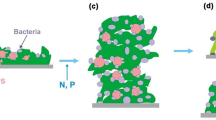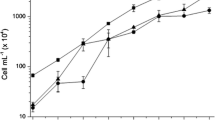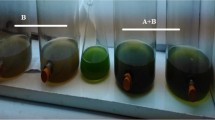Abstract
Algae–bacteria symbiosis can promote the growth of microalgae and improve the efficiency of wastewater treatment. Attached culture is an efficient culture technique for microalgae, with benefits of high yield, low water consumption and easy harvesting. However, the promoting effects of bacteria on microalgae in attached culture are still unclear. In this study, different forms of a nitrogen-fixing bacteria, Azotobacter beijerinckii (including bacteria supernatant, live bacteria, and broken bacteria), were co-cultured with Chlorella pyrenoidosa in an attached culture system using wastewater as the culture medium. The results showed that the broken A. beijerinckii form had the best growth promotion effect on C. pyrenoidosa. Compared with the pure algae culture, the biomass of C. pyrenoidosa increased by 71.8% and the protein increased by 28.2%. The live bacteria form had the best effect on improving the efficiency of wastewater treatment by C. pyrenoidosa, with the COD, PO43− and NH4+–N removal rates increased by 20.8%, 18.5% and 8.9%, respectively, in comparison with the pure algae culture. The attached co-culture mode promoted the growth of C. pyrenodisa better than the suspended co-culture mode. This research offers a new way for improving microalgae biomass and wastewater treatment by attached algae–bacteria symbiont.







Similar content being viewed by others
Data availability
All date generated or analyzed during this study are included in this published article or are available from the corresponding author on reasonable request.
References
Paul C, Pohnert G (2011) Production and role of volatile halogenated compounds from marine algae. ChemInform 42(21):186
Jia H, Yuan Q, Rein A (2016) Removal of nitrogen from wastewater using microalgae and microalgae–bacteria consortia. Cogent Environ Sci 2(1):1275089
Liu W, Cui YQ, Cheng PF, Huo SH, Ma XC, Chen QF, Cobb K, Chen P, Ma JJ, Gao XG, Ruan R (2020) Microwave assisted flocculation for harvesting of Chlorella vulgaris. Bioresour Technol 314:123770
Bolch C, Subramanian TA, Green DH (2011) The toxic dinoflagellate gymnodinium catenatum (Dinophyceae) requires marine bacteria for growth. J Phycol 47(5):1009–1022
Grant MA, Kazamia E, Cicuta P, Smith AG (2014) Direct exchange of vitamin B12 is demonstrated by modelling the growth dynamics of algal-bacterial cocultures. Isme J 8(7):1418–1427
Cho DH, Ramanan R, Heo J, Lee J, Kim HS (2015) Enhancing microalgal biomass productivity by engineering a microalgal-bacterial community. Bioresour Technol 175:578–585
Tadashi T, Mari K, Tsubasa H, Naoto K, Yasuhiro T, Daisuke I, Kazunari S, Masaaki M, Kazuhiro M (2018) Growth promotion of three microalgae, Chlamydomonas reinhardtii, Chlorella vulgaris and Euglena gracilis, by in situ indigenous bacteria in wastewater effluent. Biotechnol Biofuels 11:176
Xue LG, Shang H, Ma P (2018) Analysis of growth and lipid production characteristics of Chlorella vulgaris in artificially constructed consortia with symbiotic bacteria. J Basic Microbiol 58(4):358–367
Oswald WJ, Gotaas HB, Golueke CG, Kellen WR (1957) Algae in waste treatment. Sewage Ind Waste 29(4):437–455
Brennan L, Owende P (2010) Biofuels from microalgae—a review of technologies for production, processing, and extractions of biofuels and co-products. Renew Sust Energ Rev 14(2):557–577
Wang J, Han D, Sommerfeld MR, Lu C, Hu Q (2013) Effect of initial biomass density on growth and astaxanthin production of Haematococcus pluvialis in an outdoor photobioreactor. J Appl Phycol 25(1):253–260
Davis R, Aden A, Pienkos PT (2011) Techno-economic analysis of autotrophic microalgae for fuel production. Appl Energ 88(10):3524–3531
Zhang TY, Hu HY, Wu YH, Zhuang LL, Xu XQ, Wang XX, Dao GH (2016) Promising solutions to solve the bottlenecks in the large-scale cultivation of microalgae for biomass/bioenergy production. Renew Sustain Energy Rev 60:1602–1614
Liu TZ, Wang JF, Hu Q, Cheng PF, Bei J, Liu JL, Chen Y, Zhang W, Chen XL, Chen L, Gao LL, Ji CL, Wang H (2013) Attached cultivation technology of microalgae for efficient biomass feedstock production. Bioresour Technol 127:216–222
Ozkan A, Kinney K, Katz L, Berberoglu H (2012) Reduction of water and energy requirement of algae cultivation using an algae biofilm photobioreactor. Bioresour Technol 114:542–548
Wei ZJ, Xiao LI, Wang HN, Yin YH, Jun XL, Sheng GB (2019) Enhanced biomass production and lipid accumulation by co-cultivation of Chlorella vulgaris with Azotobacter Mesorhizobium sp. Chin Biotech 39(7):56–64
Hernandez JP, De-Bashan LE, Rodriguez DJ, Rodriguez Y, Bashan Y (2009) Growth promotion of the freshwater microalga Chlorella vulgaris by the nitrogen-fixing, plant growth-promoting bacterium Bacillus pumilus from arid zone soils. Eur J Soil Biol 45:88–93
Xu LL, Cheng XL, Wang QX (2018) Enhanced lipid production in Chlamydomonas reinhardtii by co-culturing with Azotobacter chroococcum. Front Plant Sci 9:741
Lichtenthaler HK (1987) Chlorophylls and carotenoids: pigments of photosynthetic biomembranes. Method Enzymol 148:350–382
Bradford MM (1976) A rapid and sensitive method for the quantification of microgram quantities of protein utilizing the principle of protein dye-binding. Anal Biochem 72(1–2):248–254
Dubois M, Gilles KA, Hamilton JK, Rebers PA, Smith F (1956) Colorimetric method for determination of sugars and related substances. Anal Chem 28(3):350–356
Bligh EG, Dyer WJ (1959) A rapid methos of total lipid extraction and purification. Can J Biochem Physiol 37(8):911–917
Eaton AD, Clesceri LS, Greenberg AE, Franson MA (1966) Standard methods for the examination of water and wastewater. Am J Public Health Nations Health 56(3):387–388
Yao N, Liu Z, Chen Y, Zhou Y, Xie B (2015) A novel thermal sensor for the sensitive measurement of chemical oxygen demand. Sensors 15(8):20501–20510
Omar H, Aljudaibiand A, Elgendy A (2018) Abstract: Antimicrobial, antioxidant, anticancer activity and phytochemical analysis of the red algae, Laurencia papillosa. Int J Pharmacol 14(4):572–583
Demmig-Adams B (1996) Chlorophyll and carotenoid composition in leaves of Euonymus kiautschovicus acclimated to different degrees of light stress in the field. Funct Plant Biol 23(5):649–659
Yu Z, Pei HY, Li YZ, Yang ZG, Zhen X, Hou QJ, Nie CL (2020) Inclined algal biofilm photobioreactor (IABPBR) for cost-effective cultivation of lipid-rich microalgae and treatment of seawater-diluted anaerobically digested effluent. Bioresour Technol 315:123761
Liu X, Zhang S, Shan XQ, Christie P (2007) Combined toxicity of cadmium and arsenate to wheat seedlings and plant uptake and antioxidative enzyme responses to cadmium and arsenate co-contamination. Ecotox Environ Safe 68(2):305–313
Sharma P, Dubey RS (2007) Involvement of oxidative stress and role of antioxidative defense system in growing rice seedlings exposed to toxic concentrations of aluminum. Plant Cell Rep 26(11):2027–2038
Liu CR, Chen ZP, Zhang ZW (2008) The effects of Aeromonas hydrophila-lipopolysaccharide and Sparasiscrispa-polysaccharide on the immune and digestion function of loach (Misgurnusanguillicaudatus). Mar Sci 32:1–9
Xu YJ, Shan HW, Ma S (2015) Effect of Bacillus sp. and Vibroio alginolyticus on the activities of digestive and immune enzymes disease resistance of Litopenaeus vannamei. Period Ocean Univ China 45:046–053
Zhang B, Chen JC, Su YR, Sun WX, Zhang AL (2021) Utilization of Indole-3-acetic acid–secreting bacteria in algal environment to increase biomass accumulation of ochromonas and Chlorella. Bioenerg Res 15:1–11
Fuentes-Ramirez LE, Jimenez-Salgado T, Abarca-Ocampo IR, Caballero-Mellado J (2018) Acetobacter diazotrophicus, an indoleacetic acid producing bacterium isolated from sugarcane cultivars of Mexico. Plant Soil 154:145–150
Zhang B, Chen J, Su Y, Sun W, Zhang A (2021) Utilization of Indole-3-acetic acid–secreting bacteria in algal environment to increase biomass accumulation of Ochromonas and Chlorella. Bioenerg Res 2021:1–11
Li T, Mahmoud G, Feng J (2015) Regulation of starch and lipid accumulation in a microalgal Chorellasorokiniana. Bioresour Technol 180:250–257
Yun H, Wei X, Qiang L, Qian F, Xia A, Zhu X, Sun YH (2016) Comparison of Chlorella vulgaris biomass productivity cultivated in biofilm and suspension from the aspect of light transmission and microalgae affinity to carbon dioxide. Bioresour Technol 222:367–373
Gross M, Henry W, Michael C, Wen Z (2013) Development of a rotating algal biofilm growth system for attached microalgae growth with in situ biomass harvest. Bioresour Technol 150:195–201
Wang JF, Liu JL, Liu TZ (2015) The difference in effective light penetration may explain the superiority in photosynthetic efficiency of attached cultivation over the conventional open pond for microalgae. Biotechnol Biofuels 8:49
Song XY, Luo WH, Mcdonald J (2018) An anaerobic membrane bioreactor-membrane distillation hybrid system for energy recovery and water reuse: removal performance of organic carbon, nutrients, and trace organic contaminants. Sci Total Environ 628–629:358–365
Zhang L, Chen L, Wang J, Chen Y, Gao X, Zhang Z, Liu TZ (2015) Attached cultivation for improving the biomass productivity of Spirulina platensis. Bioresour Technol 181:136–142
Singhl G, Patidar SK (2020) Development and applications of attached growth system for microalgae biomass production. Bioenerg Res 14(3):709–722
Acknowledgements
The current study was partly funded by the Innovation Ability Improvement Project of Small and Medium-sized High-tech Company in Shandong Province (2022TSGC2199); Natural Science Foundation of Shandong Province (ZR2022MC204; ZR2019MB073); Major Science and Technology Innovation Projects in Shandong Province (2019JZZY010723); and National Natural Science Foundation of China (22176104).
Funding
This study was supported by the Innovation Ability Improvement Project of Small and Medium-sized High-tech Company in Shandong Province, 2022TSGC2199, Natural Science Foundation of Shandong Province, ZR2022MC204, ZR2019MB073, Major Science and Technology Innovation Projects in Shandong Province, 2019JZZY010723, and National Natural Science Foundation of China, 22176104.
Author information
Authors and Affiliations
Contributions
HD: conceptualization, data curation, formal analysis, and writing—original draft. WL: supervision, funding acquisition, data curation, and writing—review and editing. HZ: methodology and data curation. ZW: investigation. FF: data curation. LZ: data curation and investigation. HD: data curation and investigation. TX: data curation. XL: investigation. JM: data curation and investigation.
Corresponding author
Ethics declarations
Conflict of interest
The authors declare no conflict of interest.
Ethical approval and consent to participate
This manuscript does not involve any human participants, human data, human tissue, individual person’s data or animal experiment.
Additional information
Publisher's Note
Springer Nature remains neutral with regard to jurisdictional claims in published maps and institutional affiliations.
Rights and permissions
Springer Nature or its licensor (e.g. a society or other partner) holds exclusive rights to this article under a publishing agreement with the author(s) or other rightsholder(s); author self-archiving of the accepted manuscript version of this article is solely governed by the terms of such publishing agreement and applicable law.
About this article
Cite this article
Dong, H., Liu, W., Zhang, H. et al. Enhanced biomass production and wastewater treatment in attached co-culture of Chlorella pyrenoidosa with nitrogen-fixing bacteria Azotobacter beijerinckii. Bioprocess Biosyst Eng 46, 707–716 (2023). https://doi.org/10.1007/s00449-023-02855-8
Received:
Accepted:
Published:
Issue Date:
DOI: https://doi.org/10.1007/s00449-023-02855-8




